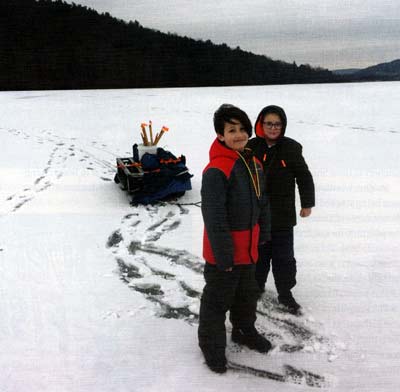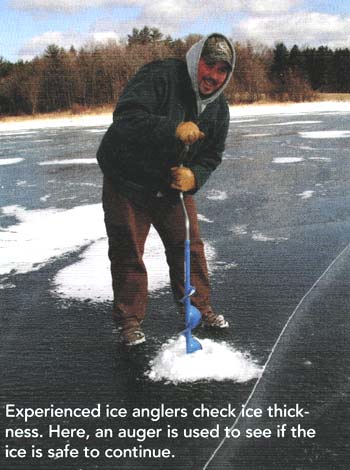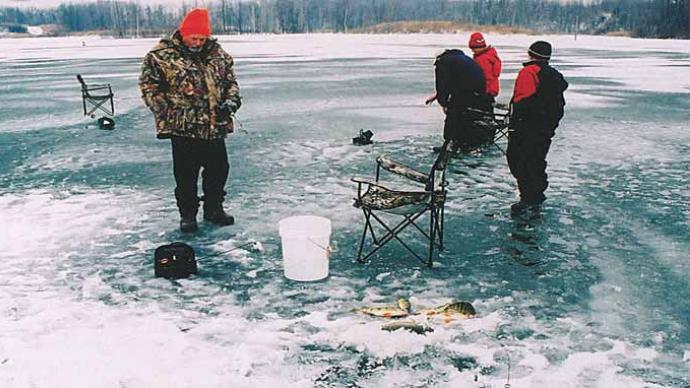
Ice is a remarkable solid.
Uniquely, ice floats on top of its liquid state, water. It turns out that this unusual characteristic is essential for life on Earth as we know it. Imagine if ice sank; ice at the bottom of a lake might never melt during the summer. Eventually, more ice would form and sink the following winter. Eventually, bodies of water in mid- and upper latitudes (closer to the poles and farther from the equator, or 0 latitude) would freeze solid. Depending on perspective, that might make pond management a bit more challenging or quite simple!
Ice, that remarkable floating solid, can create wonderful winter fun opportunities and potentially dangerous situations. Keeping a few safety basics in mind can go a long way to making sure winter ice activities are safe and fun. First, work with a trusted adult familiar with ice safety rules. Ice-fishing people are a great source of information because they are often up to date on local ice conditions, have the added benefit of an ice auger, and can easily test the ice conditions and thickness. However, discuss family ice safety rules first and make sure that whoever is helping understands the family's ice safety rules.
Responsible ice-fishers will respect family rules and be happy to report ice conditions accurately so that everyone can make decisions they are comfortable with.
Most state agencies consider 4 inches of good, dark ice suitable for a single person, such as a lone ice fisher. Eight inches of ice is considered suitable for a person on an ATV or snowmobile, 12 inches for a small vehicle, and more than 12 inches for a truck, depending on the weight.
Remember that not all ice is equal; ice formed rapidly during a deep cold snap (dark ice) is much stronger than ice formed during a freeze-thaw period. Ice with snow is of even poorer quality and generally considered unsafe.
Secondly, ice does not form uniformly on most bodies of water. Currents, springs, and even changing water depths can affect ice thickness. It is always a good idea to test the ice depth many times. For example, last winter, a local body of water that "always" ices over fast with good ice and with increasing ice depth in the middle, iced over late with ice that thinned rapidly a short distance from shore. Luckily, the first people out were ice-fishers who drilled holes found that they were on very thin ice, and safely got off.
There are a few simple tips to increase ice safety:
- Ensure responsible people know who is on the ice and when they are expected to return.
- Ice picks can make getting out of the water and back onto the ice much easier. Ice picks can be homemade from nails, tape, and string or purchased from many stores and must be carried somewhere accessible during an emergency. Many people carry them around their necks.
- It's a good idea to be familiar with basic ice rescue techniques for yourself or for helping other people.
There are multiple videos online from reputable sources.

Why is falling through the ice such a big deal, anyway? A person who has fallen through the ice faces several serious problems. First, it is possible to fall through the ice and lose track of the hole they fell through, making it impossible to get out. Secondly, water with ice is frigid (obviously), and a human body in cold water will quickly develop hypothermia (being too cold). This causes the person in the water to lose consciousness and no longer be able to swim or act logically. Also, winter clothing is bulky and absorbs much water, quickly becoming heavy and acting as a weight.
Additionally, the edges of the ice that have been fallen through are usually weakened, wet, and slippery (this is where the ice picks help) and are difficult to crawl back onto. Falling through the ice is something to be cautious about.
Is all the potential dangers of thin or weak ice worth it?
I fell through the ice when I was five, and I remember it well over 40 years later. It was scary. But I still go out on dark, uniform ice over 6" thick. There's some great stuff out there! My favorites are ice hockey and sledding onto ice from a hill.
Ice fishing, ice skating, and ice boating are also fun and popular ice sports. Ice fishing is a truly unique way of fishing that allows more anglers access to areas of ponds and lakes that require a boat in the summer. For even more fun, when the ice is thick enough, people can get together and fish in larger groups, which is impossible on water. This makes fishing feel a lot like a summer barbeque at a park! Because fish eat and hang out in different areas of ponds and lakes during the winter, ice fishing is a whole different game, meaning there will be new challenges and successes.
If there is good ice near you anytime this winter, keep safety in mind, dress warm, and try something new and exciting!
Christine Cornwell is a horse trainer who lives in upstate New York with her husband and son. She worked for the New York State Department of Environmental Conservation as a high school science teacher. Sharing her love of a healthy, natural world is a daily passion.
Reprinted with permission from Pond Boss Magazine



